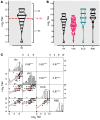Convalescent plasma anti-SARS-CoV-2 spike protein ectodomain and receptor-binding domain IgG correlate with virus neutralization
- PMID: 32910806
- PMCID: PMC7685744
- DOI: 10.1172/JCI141206
Convalescent plasma anti-SARS-CoV-2 spike protein ectodomain and receptor-binding domain IgG correlate with virus neutralization
Abstract
The newly emerged severe acute respiratory syndrome coronavirus 2 (SARS-CoV-2) highlights the urgent need for assays that detect protective levels of neutralizing antibodies. We studied the relationship among anti-spike ectodomain (anti-ECD), anti-receptor-binding domain (anti-RBD) IgG titers, and SARS-CoV-2 virus neutralization (VN) titers generated by 2 in vitro assays using convalescent plasma samples from 68 patients with COVID-19. We report a strong positive correlation between both plasma anti-RBD and anti-ECD IgG titers and in vitro VN titers. The probability of a VN titer of ≥160, the FDA-recommended level for convalescent plasma used for COVID-19 treatment, was ≥80% when anti-RBD or anti-ECD titers were ≥1:1350. Of all donors, 37% lacked VN titers of ≥160. Dyspnea, hospitalization, and disease severity were significantly associated with higher VN titer. Frequent donation of convalescent plasma did not significantly decrease VN or IgG titers. Analysis of 2814 asymptomatic adults found 73 individuals with anti-ECD IgG titers of ≥1:50 and strong positive correlation with anti-RBD and VN titers. Fourteen of these individuals had VN titers of ≥1:160, and all of them had anti-RBD titers of ≥1:1350. We conclude that anti-RBD or anti-ECD IgG titers can serve as a surrogate for VN titers to identify suitable plasma donors. Plasma anti-RBD or anti-ECD titers of ≥1:1350 may provide critical information about protection against COVID-19 disease.
Keywords: Adaptive immunity; Cellular immune response; Immunology; Infectious disease; Molecular pathology.
Conflict of interest statement
Figures



Update of
-
Relationship between Anti-Spike Protein Antibody Titers and SARS-CoV-2 In Vitro Virus Neutralization in Convalescent Plasma.bioRxiv [Preprint]. 2020 Jun 9:2020.06.08.138990. doi: 10.1101/2020.06.08.138990. bioRxiv. 2020. Update in: J Clin Invest. 2020 Dec 1;130(12):6728-6738. doi: 10.1172/JCI141206. PMID: 32577662 Free PMC article. Updated. Preprint.
References
-
- Centers for Disease Control and Prevention. United States COVID-19 Cases and Deaths by State. CDC COVID Data Tracker. https://www.cdc.gov/coronavirus/2019-ncov/cases-updates/cases-in-us.html Accessed June 1, 2020.
-
- Beigel JH, et al. Remdesivir for the treatment of Covid-19 — preliminary report. N Engl J Med. 2020:NEJMoa2007764 - PubMed
-
- doi: 10.1101/2020.07.29.20162917. Joyner MJ, et al. Evidence favouring the efficacy of convalescent plasma for COVID-19 therapy [preprint]. Posted on medRxiv August 28, 2020. - DOI
Publication types
MeSH terms
Substances
Grants and funding
LinkOut - more resources
Full Text Sources
Medical
Miscellaneous

